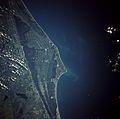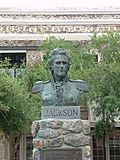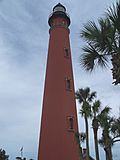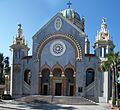List of National Historic Landmarks in Florida facts for kids
The National Historic Landmarks in Florida are representations of a broad sweep of history from Pre-Columbian times, through the Second Seminole War and Civil War, and the Space Age. There are 47 National Historic Landmarks (NHLs) in Florida, which are located in twenty-two of the state's sixty-seven counties. Sixteen of the NHLs in the state are significant examples of a particular architectural style, eleven have military significance, ten are archaeological sites, three were the homes of well-known American authors, and one is associated with the development of the U.S. Space Program.
Six sites are in state parks and managed by the Florida Department of Environmental Protection.
Also included is a site determined eligible for National Historic Landmark status, and a list of historical sites in Florida managed by the U.S. National Park Service which also have national significance.
The National Historic Landmark program is administered by the National Park Service, a branch of the Department of the Interior. The National Park Service determines which properties meet NHL criteria and makes nomination recommendations after an owner notification process. The Secretary of the Interior reviews nominations and, based on a set of predetermined criteria, makes a decision on NHL designation or a determination of eligibility for designation. Both public and privately owned properties are designated as NHLs. This designation provides indirect, partial protection of the historic integrity of the properties, via tax incentives, grants, monitoring of threats, and other means. Owners may object to the nomination of the property as an NHL. When this is the case the Secretary of the Interior can only designate a site as eligible for designation.
NHLs are also included on the National Register of Historic Places (NRHP), which are historic properties that the National Park Service deems to be worthy of preservation. The primary difference between an NHL and a NRHP listing is that the NHLs are determined to have national significance, while other NRHP properties are deemed significant at the local or state level. The NHLs in Florida comprise 2.6% of the approximately 1,600 properties and districts listed on the National Register of Historic Places in Florida.
Contents
Current NHLs
| Landmark name | Image | Date designated | Location | County | Description | |
|---|---|---|---|---|---|---|
| 1 | Mary McLeod Bethune Home |
(#74000655) |
Daytona Beach 29°12′39″N 81°01′56″W / 29.210789°N 81.032098°W |
Volusia | Home of Mary McLeod Bethune, educator and civil rights leader | |
| 2 | Bok Tower Gardens |
(#72000350) |
Lake Wales 27°56′06″N 81°34′37″W / 27.935°N 81.576944°W |
Polk | Constructed by Ladies Home Journal editor Edward W. Bok on the highest hill in the area to create "a spot of beauty second to none in the country" | |
| 3 | British Fort |
(#72000318) |
Sumatra 29°56′23″N 85°00′45″W / 29.939767°N 85.012499°W |
Franklin | Built during the War of 1812 and also known as Negro Fort, it was the location of a fortification occupied by runaway slaves, as well as Native Americans living in the area. Due to a massive explosion near the end of the war, nothing remains of the fort. | |
| 4 | Cape Canaveral Space Force Station |
(#84003872) |
Cocoa 28°29′20″N 80°34′40″W / 28.488889°N 80.577778°W |
Brevard | The East Coast space launch facility of the United States Space Force, and adjacent to the Kennedy Space Center | |
| 5 | Cathedral Of St. Augustine |
(#70000844) |
St.Augustine 29°53′29″N 81°18′45″W / 29.891286°N 81.312368°W |
St. Johns | Completed in 1797, it was severely damaged by fire in 1887, but restored over the next two years. It is part of the St. Augustine Town Plan Historic District | |
| 6 | Crystal River Site |
(#70000178) |
Crystal River 28°55′01″N 82°36′33″W / 28.916944°N 82.609167°W |
Citrus | A ceremonial center and burial complex, occupied during the Deptford, Weeden Island, and Safety Harbor periods | |
| 7 | Dade Battlefield |
(#72000353) |
Bushnell 28°39′08″N 82°07′36″W / 28.652222°N 82.126667°W |
Sumter | Site of the Dade Massacre during the Second Seminole War, it is now a state park | |
| 8 | Marjory Stoneman Douglas House |
(#15000312) |
Miami 27°57′37″N 82°26′32″W / 27.960253°N 82.442283°W |
Miami-Dade County | Home of noted environmentalist and activist Marjory Stoneman Douglas. | |
| 9 | Dudley Farm |
(#100006234) |
18730 West Newberry Road 29°39′15″N 82°32′37″W / 29.6542°N 82.5436°W |
Alachua | A fine example of a late-19th to early-20th century farm. | |
| 10 | El Centro Español de Tampa |
(#88001823) |
Tampa 27°57′37″N 82°26′32″W / 27.960253°N 82.442283°W |
Hillsborough | Home of the first mutual aid society in Florida, and part of the Ybor City Historic District | |
| 11 | Ferdinand Magellan - U.S. Car No. 1 |
(#77000401) |
Miami 25°37′03″N 80°24′00″W / 25.6175°N 80.4°W |
Miami-Dade | The first passenger railcar built for a President since the one made for Lincoln in 1865. It was used by FDR, Truman, Eisenhower, and briefly by Reagan. | |
| 12 | Florida Southern College Historic District |
(#75000568) |
Lakeland 28°01′52″N 81°56′48″W / 28.031111°N 81.946667°W |
Polk | Contains the largest single-site collection of Frank Lloyd Wright architecture. | |
| 13 | Fort King Site |
(#04000320) |
Ocala 29°11′20″N 82°04′56″W / 29.188889°N 82.082222°W |
Marion | Site of fort prominent before and during the Second Seminole War. It was located at a nexus of military roads reaching from Tampa to Jacksonville | |
| 14 | Fort Mose Site |
(#94001645) |
St.Augustine 29°55′40″N 81°19′31″W / 29.927689°N 81.325169°W |
St. Johns | First free Black settlement legally sanctioned in what would become the United States. Runaway slaves from the Southern colonies escaped to freedom here during the early to mid 18th century, making this a precursor to the Underground Railroad. | |
| 15 | Fort San Carlos De Barrancas |
(#66000263) |
Pensacola 30°20′52″N 87°17′51″W / 30.347839°N 87.297561°W |
Escambia | Site of a series of forts going back as far as 1698, now part of the Gulf Islands National Seashore. | |
| 16 | Fort San Marcos De Apalache |
(#66000271) |
St. Marks 30°09′18″N 84°12′40″W / 30.155°N 84.211111°W |
Wakulla | Wooden or masonry forts were at this site during Spanish or British colonial periods, and the Second Seminole War. The Spanish fort's capture in 1818 by Jackson led the U.S. to acquire Florida in 1821. | |
| 17 | Fort Walton Mound |
(#66000268) |
Fort Walton Beach 30°24′13″N 86°36′27″W / 30.403611°N 86.6075°W |
Okaloosa | Type site of the Fort Walton Culture | |
| 18 | Fort Zachary Taylor |
(#71000244) |
Key West 24°32′46″N 81°48′37″W / 24.546094°N 81.810292°W |
Monroe | Controlled by the Union during the Civil War, later used heavily during the Spanish–American War, it is now a state park | |
| 19 | Freedom Tower |
(#79000665) |
Miami 25°46′48″N 80°11′23″W / 25.78°N 80.189722°W |
Miami-Dade | The original headquarters and printing facility of the Miami News & Metropolis newspaper; later made a memorial to Cuban immigration to the U.S. | |
| 20 | González-Alvarez House |
(#70000845) |
St.Augustine 29°53′17″N 81°18′36″W / 29.888004°N 81.310038°W |
St. Johns | The oldest house in St. Augustine, built in the early 18th century, and part of the St. Augustine Town Plan Historic District | |
| 21 | Governor Stone (schooner) |
(#91002063) |
Panama City 30°10′03″N 85°42′09″W / 30.167521°N 85.702600°W |
Bay | Built in 1877, it is the oldest surviving Gulf-built two-masted coasting schooner | |
| 22 | Ernest Hemingway House |
(#68000023) |
Key West 24°33′04″N 81°48′03″W / 24.551179°N 81.800903°W |
Monroe | A home of author Ernest Hemingway | |
| 23 | Hotel Ponce de Leon |
(#75002067) |
St.Augustine 29°53′32″N 81°18′51″W / 29.892129°N 81.314252°W |
St. Johns | Built in 1887-88 by Carrère and Hastings for real estate and railroad tycoon Henry Flagler, it is the first large scale building constructed entirely of poured concrete. The only Flagler Hotel to survive the Great Depression, it later became part of Flagler College. Part of St. Augustine Town Plan Historic District | |
| 24 | Zora Neale Hurston House |
(#91002047) |
Fort Pierce 27°27′39″N 80°20′31″W / 27.460777°N 80.342009°W |
St. Lucie | A home of author Zora Neale Hurston | |
| 25 | Ingham (USCGC) |
(#92001879) |
Key West 24°38′08″N 81°48′28″W / 24.635555555555555°N 81.80777777777777°W |
Monroe | Built at Philadelphia Naval Shipyard in 1935 and launched in 1936. Served on North Atlantic Convoys and credited with sinking u-boat 626. Served in Mediterranean and African Convoys and then landings in the Philippines. Served through Korea and received two Presidential Unit Citations for service in Viet-Nam. Served in Key West during the Mariel Boat lift in 1980 and retired in 1988 after 52 years of service. She remains the most decorated cutter in Coast Guard History. | |
| 26 | Llambias House |
(#70000846) |
St.Augustine 29°53′16″N 81°18′39″W / 29.887907°N 81.310969°W |
St. Johns | Built in the late 18th century, and part of the St. Augustine Town Plan Historic District | |
| 27 | Maple Leaf (shipwreck) |
(#94001650) |
Mandarin 30°09′30″N 81°41′12″W / 30.158333°N 81.686667°W |
Duval | Launched in 1851, it was sunk by the Confederates in 1864, and is one of the best preserved Civil War shipwrecks | |
| 28 | Mar-a-Lago |
(#80000961) |
Palm Beach 26°40′40″N 80°02′10″W / 26.677885°N 80.036057°W |
Palm Beach | The former estate of Marjorie Merriweather Post. | |
| 29 | Miami Biltmore Hotel & Country Club |
(#72000306) |
Coral Gables 25°44′28″N 80°16′45″W / 25.741111°N 80.279167°W |
Miami-Dade | A luxury Biltmore Hotel opened in 1926, it was the tallest building in Florida until 1928, and also served as a hospital during World War II. | |
| 30 | The Miami Circle at Brickell Point Site |
(#01001534) |
Miami 25°46′10″N 80°11′24″W / 25.769381°N 80.189919°W |
Miami-Dade | An important site related to the Tequesta | |
| 31 | Mud Lake Canal |
(#06000979) |
Flamingo 25°10′26″N 80°56′17″W / 25.174°N 80.938°W |
Monroe | Prehistoric long-distance canoe canal | |
| 32 | Norman Film Manufacturing Company |
(#14001084) |
Jacksonville 30°20′02″N 81°35′37″W / 30.33379°N 81.59365°W |
Duval | A rare, extant silent film studio and the only surviving race film studio in America; it never transitioned to sound production. | |
| 33 | Okeechobee Battlefield |
(#66000269) |
Okeechobee 27°12′04″N 80°46′09″W / 27.201111°N 80.769167°W |
Okeechobee | Site of the Battle of Lake Okeechobee, one of the major conflicts during the Second Seminole War | |
| 34 | Pelican Island National Wildlife Refuge |
(#66000265) |
Sebastian 27°48′00″N 80°26′00″W / 27.8°N 80.4333°W |
Indian River | Established by an executive order of President Theodore Roosevelt in 1903, this was the first national wildlife refuge in the United States. | |
| 35 | Pensacola Naval Air Station Historic District |
(#76000595) |
Pensacola 30°20′52″N 87°17′50″W / 30.3478°N 87.2972°W |
Escambia | Opened in 1914, as the first U.S. permanent naval air station, first Navy pilot training center, and first U.S. naval installation to send pilots into combat. | |
| 36 | Plaza Ferdinand VII |
(#66000264) |
Pensacola 30°24′27″N 87°12′50″W / 30.407406°N 87.213948°W |
Escambia | Place where Florida was formally transferred from Spain to the U.S., in 1821 | |
| 37 | Ponce de Leon Inlet Light Station |
(#72000355) |
Ponce Inlet 29°04′44″N 80°55′42″W / 29.078961°N 80.928334°W |
Volusia | Completed in 1887, it is the tallest lighthouse in Florida (at 175 feet (53 m) in height) | |
| 38 | Marjorie Kinnan Rawlings House and Farm Yard |
(#70000176) |
Cross Creek 29°28′49″N 82°09′42″W / 29.4803°N 82.1617°W |
Alachua | A home of author Marjorie Kinnan Rawlings | |
| 39 | The Research Studio (Maitland Art Center) |
(#14000920) |
Maitland 28°37′32″N 81°22′03″W / 28.625556°N 81.3675°W |
Orange | Artist J. Andre Smith founded the Center as an artist colony in 1937. With over 200 carvings and reliefs, it is an important example of Art Deco fantasy and Mayan Revival architecture in the United States. | |
| 40 | Safety Harbor site |
(#66000270) |
Safety Harbor 28°00′32″N 82°40′39″W / 28.008889°N 82.6775°W |
Pinellas | The largest remaining mound in the Tampa Bay area, and believed to have been the location of the "capital city" of the Tocobaga | |
| 41 | San Luis De Talimali (formerly San Luis de Apalache) |
(#66000266) |
Tallahassee 30°26′57″N 84°19′12″W / 30.44909°N 84.319905°W |
Leon | A Spanish Franciscan mission was built here in 1633 in the descendent settlement of Anhaica, capital of Apalachee Province. It was abandoned and destroyed in 1704 to prevent use by the British. | |
| 42 | St. Augustine Town Plan Historic District |
(#70000847) |
St.Augustine 29°53′31″N 81°18′51″W / 29.89204°N 81.31428°W |
St. Johns | The district's boundaries are roughly those of the original town of St. Augustine, and covers the period of development from 1672 to 1935. | |
| 43 | Tampa Bay Hotel |
(#72000322) |
Tampa 27°56′44″N 82°27′50″W / 27.945472°N 82.464013°W |
Hillsborough | Built by railroad magnate Henry B. Plant in a Moorish Revival style, and considered his premier hotel, it covers 6 acres (24,000 m2) and is .25 miles (0.40 km) long | |
| 44 | Vizcaya |
(#70000181) |
Miami 25°44′37″N 80°12′37″W / 25.743611°N 80.210278°W |
Miami-Dade | Winter residence of industrialist James Deering | |
| 45 | Whitehall (Henry M. Flagler House) |
(#72000345) |
Palm Beach 26°42′52″N 80°02′30″W / 26.714307°N 80.041653°W |
Palm Beach | A home of industrialist Henry Morrison Flagler | |
| 46 | Windover Archeological Site |
(#87000810) |
Titusville 28°32′19″N 80°50′36″W / 28.538537°N 80.843239°W |
Brevard | A peat deposit preserving artifacts and human burials dating to the Early Archaic period. One of the largest collections of human skeletal material of its time, and of fiber arts from any New World archeological site. | |
| 47 | Ybor City Historic District |
(#74000641) |
Tampa 27°57′54″N 82°26′06″W / 27.965°N 82.435°W |
Hillsborough | Has the largest collection of buildings related to the U.S. cigar industry; was a rare multi-ethnic & multi-racial industrial community of the Deep South in the late 19th and early 20th centuries. |
Eligible National Historic Landmark
The following property was determined eligible for National Historic Landmark status, but did not become one. It is listed on the National Register of Historic Places.
| Landmark name | Image | Date declared | Location | County | Description | |
|---|---|---|---|---|---|---|
| 1 | Hialeah Park Race Track |  |
January 11, 1988 | Hialeah 25°50′46″N 80°16′37″W / 25.846°N 80.277°W |
Miami-Dade | Built in 1921, the greyhound track is one of the oldest existing recreational facilities in southern Florida, and contributed to South Florida's popularity as a winter resort for the rich and famous. It became so well known for its flamingo flocks that it was officially designated a sanctuary for them by the Audubon Society. |
Historic areas of the NPS in Florida
National Historic Sites, National Historical Parks, some National Monuments, and certain other areas listed in the National Park system are historic landmarks of national importance that are highly protected already, often before the inauguration of the NHL program in 1960, and are then often not also named NHLs per se. There are six of these in Florida. The National Park Service lists these six together with the NHLs in the state.
| Landmark name | Image | Date established |
Location | County | Description | |
|---|---|---|---|---|---|---|
| 1 | Castillo de San Marcos National Monument |  |
October 15, 1924 | St.Augustine | St. Johns | This fort was built in 1672-95 to protect early Spanish settlers. |
| 2 | De Soto National Memorial |  |
March 11, 1948 | west of Bradenton | Manatee | Commemorates the landing of Spanish explorer, Hernando de Soto in 1539. De Soto's expedition was the first extensive exploration by Europeans of what is now the southern United States. |
| 3 | Dry Tortugas National Park |  |
January 4, 1935 | west of Key West in the Gulf of Mexico | Monroe | Protects several islands, associated coral reefs and marine life, and Fort Jefferson, a huge pre-Civil War masonry fort. The name "Tortugas" was given to these islands by Ponce de Leon in 1513, for the large numbers of sea turtles ("tortugas") found in the area. |
| 4 | Fort Caroline National Memorial |  |
January 16, 1953 | Jacksonville | Duval | Commemorates the first French attempt to establish a settlement in the present United States. The fort model overlooks the original site of the French Juguenot colony of 1564-65. The French and Spanish began two centuries of colonial rivalry in North America here. |
| 5 | Fort Matanzas National Monument |  |
October 15, 1924 | south of St.Augustine | St. Johns | Built to protect Spanish settlers. Two hundred and forty-five Frenchmen who challenged Spanish dominion were killed by Spaniards here in 1565. The name Matanzas means "slaughters." |
| 6 | Timucuan Ecological and Historic Preserve |  |
February 16, 1988 | Jacksonville | Duval | A partnership between the National Park Service and local government agencies to protect the wetlands, river systems, and historic sites within Duval County near Jacksonville, Florida. Kingsley Plantation, the oldest remaining plantation in Florida, is part of the preserve. |
See also
















































